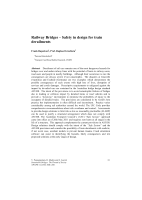Bridges

- Publication no: ABC-DES033-11
- Published: 31 October 2011
- PDF (free) Download
Derailment of rail cars remains one of the most dangerous hazards for bridges over and under railway lines with the potential of harm to railway users, road users and people in nearby buildings. Although their occurrence is rare the consequences are always severe if not catastrophic. The disasters at Granville (Australia) and Eschede (Germany) are two examples which demonstrate the possible consequences of such events with high loss of lives, disruption of services and costly damages. Prescriptive requirements to safeguard against the impact by de-railed cars are contained in the Australian bridge design standard AS5100. The intent of the provisions is to avoid catastrophic failures of bridges due to loading or collision impact by derailed trains or road vehicles and to provide a "forgiving"environment to minimise the probability of injury to the occupants of derailed trains. The provisions are considered to be world’s best practice but implementation is often difficult and inconsistent. Practice varies considerably among rail authorities around the world. The UIC Code provides comprehensive recommendations about risk avoidance and control. Assessments to provide design solutions to limit risk as low as reasonably practicable (ALARP) can be used to justify a structural arrangement which does not comply with AS5100. The Australian Transport Council’s (ATC) " Safe System"approach came into effect as of 20th May 2011 and requires zero harm at all stages in the life of a structure. This approach complements the current provisions in AS5100. Design solutions should comply with the intent of the "Safe System"and the AS5100 provisions and consider the possibility of train derailments with realistic, if not worst case, accident models to prevent human trauma. Crash simulation software can assist in identifying the hazards, likely consequences and test proposed solutions at the early stages of design.
